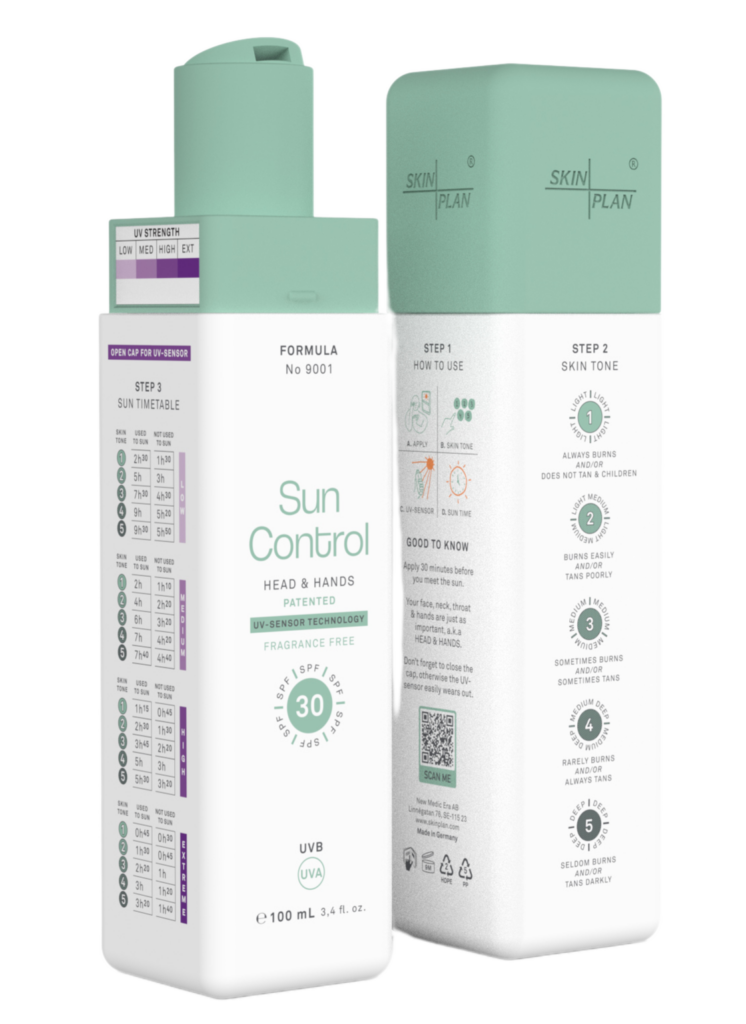
Sunscreen is one of the most important products you can ever put on your body. It protects your skin from the harmful UVA and UVB rays that the sun emits.
While many people know the importance of putting sunscreen on when they head to the beach or do other outdoor activities in the summer, most don’t know how important it is to use year-round — even when it isn’t the hottest part of the year.
In fact, an increasing number of daily cosmetic products include sun protection today.
Unfortunately, not all sunscreens are made the same. While you can certainly use a generic sunscreen for all parts of your body, it’s best to use a special sunscreen for more sensitive parts of your body, such as your hands and face.
Luckily, there’s a new product on the market called Skinplan Suncontrol that not only provides superior sun protection, but also educates you on how often you need to re-apply based on a number of personal factors.
Technically speaking, you could use the same general sunscreen on your entire body and get protection from the sun. However, dermatologists will generally advise you that’s not a good idea unless you don’t have another option. The skin on sensitive parts of your body is not the same as it is on other parts of your body. Your face and hands, in particular, have skin that’s thinner than it is on other parts of your body.
Table of Contents
Add a header to begin generating the table of contents
 Medically reviewed by: Elizabeth Williams RN
Medically reviewed by: Elizabeth Williams RN
Updated: 1/9/2025
Where Do You Need to Apply Sunscreen and How Much Do You Need to Apply?
The American Academy of Dermatology Association says that you need to apply sunscreen to all parts of your body that aren’t covered by some type of clothing. Some of the most common areas that people forget are eyelids, chest, neck, hairline and scalp, top of feet and back of hands.
It’s also important to pay special attention to parts of the body that are not covered by some types of clothing. For instance, people tend to get burned just under the collar of their shirts or under their sleeves or their shorts’ hemline.
It’s essential to use sunscreen on cloudy days, too, as 80% of UV rays from the sun penetrate through clouds. The AADA says that most adults will need roughly one ounce of sunscreen to cover their entire body.
How often you need to re-apply, though, is somewhat of an art, though it doesn’t have to be — as we’ll soon see.
Can You Use the Same Sunscreen for Your Whole Body?
Technically speaking, you could use the same general sunscreen on your entire body and get protection from the sun. However, dermatologists will generally advise you that’s not a good idea unless you don’t have another option.
But, why is this so? First and foremost, the skin on sensitive parts of your body is not the same as it is on other parts of your body.
Your face and hands, in particular, have skin that’s thinner than it is on other parts of your body. As such, these areas require more protection from the sun, since they are more susceptible to the sun’s harmful rays.
This is why it’s best to use sunscreen that’s formulated specifically for these areas of your body. Facial sunscreens, for instance, will consider the sensitivity of your eyes so that it doesn’t burn them.
Special sunscreens for your face and hands will also address the fact that these parts of the skin can show aging before others, so they often include ingredients that are anti-aging in nature.
Is There a Sunscreen That Can Protect Both Your Face and Hands Safely?
While there are many sunscreen products on the market designed specifically for the face, there is a lack of products that are safe for both the face and hands. Until now, that is.
Skinplan Suncontrol is a new high-quality sunscreen that works for the most sensitive parts of your body — your face and hands. Created by VSoft, the product has amazing ingredients as well as a formula to help you determine exactly when you need to re-apply.

Skinplan Suncontrol contains homosalate, which acts as a UV filter to absorb UVB radiation and prevent it from penetrating your skin; zinc oxide, which is a mineral sunscreen agent providing broad-spectrum protection against both UVB and UVA rays; and octisalate, which protects the skin from the harmful effects of UVB radiation.
The amazing sunscreen should be applied 30 minutes before you head outside, and make sure you cover your ears, neck, hands and face.
Then, use the product’s container to identify your specific skin tone from the five available options. Measure the sun’s intensity with the UV sensor that’s located underneath the lid. Finally, match the strength of the UV rays with your skin tone in the chart to determine your safe sun exposure time.
All you need to do at this point is set a timer for when you need to re-apply.
Get Smart Sun Protection with Skinplan Suncontrol from VSoft
Having protection from the sun is essential every time you go outside. But, it’s also essential to make sure you have the right products for the right parts of your body.
Skinplan Suncontrol from VSoft is an outstanding product that protects the most sensitive parts of your body — your hands and your face. Not only that, it comes with a built-in mechanism and formula for determining exactly when you need to re-apply.
This is important, as everyone’s skin is unique and different, meaning that re-application times are not always the same.
For more information on the amazing Skinplan Suncontrol, see the puchase page here.
